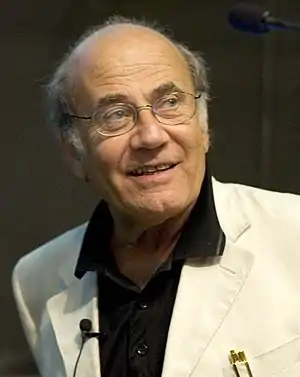Giancarlo Ghirardi | |
|---|---|
 Giancarlo Ghirardi on occasion of his 70th birthday | |
| Born | 28 October 1935 |
| Died | 1 June 2018 (aged 82) |
| Alma mater | University of Milan |
| Known for | Ghirardi–Rimini–Weber theory Dynamical reduction Quantum mechanics Quantum foundations |
| Scientific career | |
| Institutions | International School for Advanced Studies, University of Trieste |
Giancarlo Ghirardi (28 October 1935 – 1 June 2018)[1][2] was an Italian physicist and emeritus professor of theoretical physics at the University of Trieste.
He is well known for the Ghirardi–Rimini–Weber theory (GRW), which he proposed in 1985 together with Alberto Rimini and Tullio Weber,[3][4] and for his contributions to the foundations of quantum mechanics. He independently rederived, in a referee report to Foundations of Physics, the no-cloning theorem, before the works by Wootters and Zurek[5] and by Dieks[6] in 1982, but after the actual first derivation by Park[7] in 1970.
His research interests related to a variety of topics of theoretical physics, but focused beginning in 1983 mainly on the foundations of quantum mechanics.
Ghirardi was a member of the editorial boards of Foundations of Physics and Studies in History and Philosophy of Science. He was president of the Italian Society for the Foundations of Physics, of which he was one of the founding members.[8]
The President of the Province of Trieste, Maria Teresa Bassa Poropat, conferred the Sigillo della Provincia di Trieste to Giancarlo Ghirardi for research and teaching, for his commitment to the promotion and development of physics in Trieste and for his intense and fruitful activity as the author of popular books and scientific publications.
In 2017, he was awarded the Spirit of Salam prize for his extraordinary contributions to the development of the International Centre for Theoretical Physics during its budding years, both at its scientific and organizational fronts.[9]
See also
Books
- Giancarlo Ghirardi (2007). Sneaking a Look at God's Cards: Unraveling the Mysteries of Quantum Mechanics. Translated by Gerald Malsbary. Princeton: Princeton University Press. ISBN 978-0691130378.
- Shyam Wuppuluri, Giancarlo Ghirardi (2017). Space, Time and the Limits of Human Understanding. The Frontiers Collection. Cham, Switzerland: Springer. doi:10.1007/978-3-319-44418-5. ISBN 978-3-319-44417-8.
References
- ↑ Angelo Bassi, Tullio Weber, Detlef Dürr (2018). "GianCarlo Ghirardi". Physics Today. 71 (10): 60. Bibcode:2018PhT....71j..60B. doi:10.1063/PT.3.4050.
{{cite journal}}: CS1 maint: multiple names: authors list (link) - ↑ Angelo Bassi (2018). "Giancarlo Ghirardi". Nature Physics. 14 (8): 774. Bibcode:2018NatPh..14..774B. doi:10.1038/s41567-018-0249-y.
- ↑ Giancarlo Ghirardi, Alberto Rimini, Tullio Weber (1985). "A model for a unified quantum description of macroscopic and microscopic systems". Quantum Probability and Applications II. Lecture Notes in Mathematics. Vol. 1136. pp. 223–232. Bibcode:1985LNM..1136..223G. doi:10.1007/bfb0074474. ISBN 978-3-540-15661-1.
{{cite book}}: CS1 maint: multiple names: authors list (link) - ↑ Giancarlo Ghirardi, Alberto Rimini, Tullio Weber (1986). "Unified dynamics for microscopic and macroscopic systems". Physical Review D. 34 (2): 470–491. Bibcode:1986PhRvD..34..470G. doi:10.1103/PhysRevD.34.470. PMID 9957165.
{{cite journal}}: CS1 maint: multiple names: authors list (link) - ↑ Wootters, William; Zurek, Wojciech (1982). "A single quantum cannot be cloned". Nature. 299 (5886): 802–803. Bibcode:1982Natur.299..802W. doi:10.1038/299802a0. S2CID 4339227.
- ↑ Dieks, Dennis (1982). "Communication by EPR devices". Physics Letters A. 92 (6): 271–272. Bibcode:1982PhLA...92..271D. CiteSeerX 10.1.1.654.7183. doi:10.1016/0375-9601(82)90084-6. hdl:1874/16932.
- ↑ Park, James (1970). "The concept of transition in quantum mechanics". Foundations of Physics. 1 (1): 23–33. Bibcode:1970FoPh....1...23P. CiteSeerX 10.1.1.623.5267. doi:10.1007/BF00708652. S2CID 55890485.
- ↑ Giancarlo Ghirardi (in Italian)
- ↑ "ICTP - Salam Spirit Awardees Announced".
External links
- GianCarlo Ghirardi, Editorial Team member page at Quanta.
- GianCarlo Ghirardi at Google Scholar
- GianCarlo Ghirardi, The Information Philosopher
- AIPS Honours Ghirardi
- Profile, News from International Centre for Theoretical Physics (ICTP), Trieste, Italy